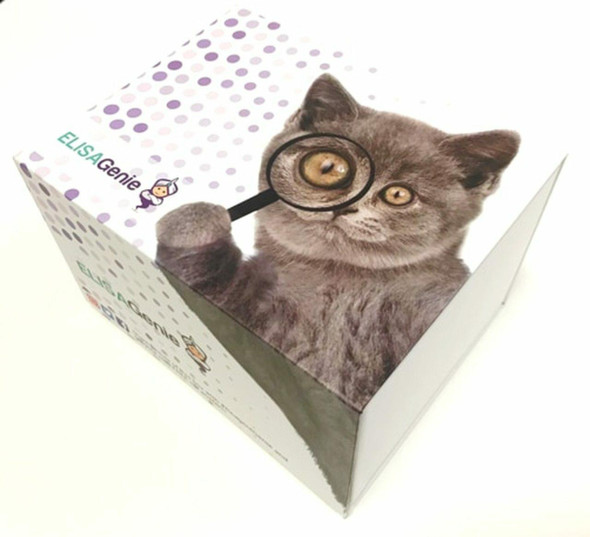Human FGF8 (Fibroblast Growth Factor 8)ELISA Kit (HUES03451)
- SKU:
- HUES03451
- Product Type:
- ELISA Kit
- Size:
- 96 Assays
- Uniprot:
- P55075
- Sensitivity:
- 7.5pg/mL
- Range:
- 12.5-800pg/mL
- ELISA Type:
- Sandwich
- Reactivity:
- Human
- Sample Type:
- Serum, plasma and other biological fluids
- Research Area:
- Developmental Biology
Description
Human FGF8 (Fibroblast Growth Factor 8) ELISA Kit
The Human FGF8 (Fibroblast Growth Factor 8) ELISA Kit is specifically designed for the precise measurement of FGF8 levels in human samples such as serum, plasma, and cell culture supernatants. This kit features exceptional sensitivity and specificity, ensuring accurate and consistent results that are suitable for a variety of research purposes.FGF8 is a key growth factor that plays a crucial role in various biological processes, including cell growth, development, and tissue repair.
Dysregulation of FGF8 has been linked to a range of diseases and disorders, making it an important biomarker for studying these conditions and potentially developing new therapeutic interventions.Overall, the Human FGF8 ELISA Kit from AssayGenie provides researchers with a reliable tool for investigating the role of FGF8 in health and disease, offering valuable insights into potential mechanisms and treatment strategies.
| Assay type: | Sandwich |
| Format: | 96T |
| Assay time: | 4.5h |
| Reactivity: | Human |
| Detection Method: | Colormetric |
| Detection Range: | 12.50-800 pg/mL |
| Sensitivity: | 7.50 pg/mL |
| Sample Volume Required Per Well: | 100µL |
| Sample Type: | Serum, plasma and other biological fluids |
| Specificity: | This kit recognizes Human FGF8 in samples. No significant cross-reactivity or interference between Human FGF8 and analogues was observed. |
This ELISA kit uses Sandwich-ELISA as the method. The micro ELISA plate provided in this kit has been pre-coated with an antibody specific to Human FGF8. Standards or samples are added to the appropriate micro ELISA plate wells and combined with the specific antibody. Then a biotinylated detection antibody specific for Human FGF8 and Avidin-Horseradish Peroxidase (HRP) conjugate are added to each micro plate well successively and incubated. Free components are washed away. The substrate solution is added to each well. Only those wells that contain Human FGF8, biotinylated detection antibody and Avidin-HRP conjugate will appear blue in color. The enzyme-substrate reaction is terminated by adding Stop Solution and the color turns yellow. The optical density (OD) is measured spectrophotometrically at a wavelength of 450 nm ± 2 nm. The OD value is proportional to the concentration of Human FGF8. The concentration of Human FGF8 in samples can be calculated by comparing the OD of the samples to the standard curve.
| UniProt Protein Function: | FGF8: Plays an important role in the regulation of embryonic development, cell proliferation, cell differentiation and cell migration. Required for normal brain, eye, ear and limb development during embryogenesis. Required for normal development of the gonadotropin-releasing hormone (GnRH) neuronal system. Defects in FGF8 are the cause of Kallmann syndrome type 6 (KAL6). Kallmann syndrome is a disorder that associates hypogonadotropic hypogonadism and anosmia. Anosmia or hyposmia is related to the absence or hypoplasia of the olfactory bulbs and tracts. Hypogonadism is due to deficiency in gonadotropin-releasing hormone and probably results from a failure of embryonic migration of gonadotropin-releasing hormone- synthesizing neurons. In some patients other developmental anomalies can be present, which include renal agenesis, cleft lip and/or palate, selective tooth agenesis, and bimanual synkinesis. In some cases anosmia may be absent or inconspicuous. Defects in FGF8 are a cause of idiopathic hypogonadotropic hypogonadism (IHH). IHH is defined as a deficiency of the pituitary secretion of follicle-stimulating hormone and luteinizing hormone, which results in the impairment of pubertal maturation and of reproductive function. Belongs to the heparin-binding growth factors family. 4 isoforms of the human protein are produced by alternative splicing. |
| UniProt Protein Details: | Protein type:Secreted; Cytokine; Secreted, signal peptide Chromosomal Location of Human Ortholog: 10q24 Cellular Component: extracellular space; extracellular region; external side of plasma membrane Molecular Function:growth factor activity; type 2 fibroblast growth factor receptor binding; type 1 fibroblast growth factor receptor binding; fibroblast growth factor receptor binding; chemoattractant activity Biological Process: gonad development; nerve growth factor receptor signaling pathway; apoptosis; cell proliferation in forebrain; adrenocorticotropin hormone secreting cell differentiation; thyroid stimulating hormone secreting cell differentiation; gastrulation; forebrain dorsal/ventral pattern formation; motor axon guidance; Wnt receptor signaling pathway through beta-catenin; mesodermal cell migration; response to organic cyclic substance; embryonic hindlimb morphogenesis; odontogenesis; BMP signaling pathway; positive chemotaxis; induction of an organ; positive regulation of cell proliferation; thyroid gland development; male genitalia development; mesonephros development; pallium development; heart looping; negative regulation of neuron apoptosis; otic vesicle formation; regulation of odontogenesis of dentine-containing teeth; negative regulation of cardiac muscle development; epidermal growth factor receptor signaling pathway; response to drug; anatomical structure morphogenesis; pharyngeal system development; phosphoinositide-mediated signaling; fibroblast growth factor receptor signaling pathway; positive regulation of mitosis; neural plate morphogenesis; MAPKKK cascade; subpallium development; forebrain morphogenesis; dorsal/ventral axon guidance; positive regulation of organ growth; patterning of blood vessels; ureteric bud branching; forebrain neuron development; midbrain-hindbrain boundary development; insulin receptor signaling pathway; innate immune response; blood vessel remodeling; response to oxidative stress; metanephros development Disease: Hypogonadotropic Hypogonadism 6 With Or Without Anosmia |
| NCBI Summary: | The protein encoded by this gene is a member of the fibroblast growth factor (FGF) family. FGF family members possess broad mitogenic and cell survival activities, and are involved in a variety of biological processes, including embryonic development, cell growth, morphogenesis, tissue repair, tumor growth and invasion. This protein is known to be a factor that supports androgen and anchorage independent growth of mammary tumor cells. Overexpression of this gene has been shown to increase tumor growth and angiogensis. The adult expression of this gene is restricted to testes and ovaries. Temporal and spatial pattern of this gene expression suggests its function as an embryonic epithelial factor. Studies of the mouse and chick homologs revealed roles in midbrain and limb development, organogenesis, embryo gastrulation and left-right axis determination. The alternative splicing of this gene results in four transcript variants. [provided by RefSeq, Jul 2008] |
| UniProt Code: | P55075 |
| NCBI GenInfo Identifier: | 1706791 |
| NCBI Gene ID: | 2253 |
| NCBI Accession: | P55075. 1 |
| UniProt Secondary Accession: | P55075,Q14915, Q15766, A1A514, |
| UniProt Related Accession: | P55075 |
| Molecular Weight: | 244 |
| NCBI Full Name: | Fibroblast growth factor 8 |
| NCBI Synonym Full Names: | fibroblast growth factor 8 (androgen-induced) |
| NCBI Official Symbol: | FGF8 |
| NCBI Official Synonym Symbols: | HH6; AIGF; KAL6; FGF-8; HBGF-8 |
| NCBI Protein Information: | fibroblast growth factor 8; androgen-induced growth factor; heparin-binding growth factor 8 |
| UniProt Protein Name: | Fibroblast growth factor 8 |
| UniProt Synonym Protein Names: | Androgen-induced growth factor; AIGF; Heparin-binding growth factor 8; HBGF-8 |
| UniProt Gene Name: | FGF8 |
| UniProt Entry Name: | FGF8_HUMAN |
As the OD values of the standard curve may vary according to the conditions of the actual assay performance (e. g. operator, pipetting technique, washing technique or temperature effects), the operator should establish a standard curve for each test. Typical standard curve and data is provided below for reference only.
| Concentration (pg/mL) | O.D | Average | Corrected |
| 800 | 2.334 2.374 | 2.354 | 2.295 |
| 400 | 1.669 1.725 | 1.697 | 1.638 |
| 200 | 0.927 0.907 | 0.917 | 0.858 |
| 100 | 0.499 0.501 | 0.5 | 0.441 |
| 50 | 0.262 0.246 | 0.254 | 0.195 |
| 25 | 0.165 0.159 | 0.162 | 0.103 |
| 12.50 | 0.108 0.116 | 0.112 | 0.053 |
| 0 | 0.051 0.067 | 0.059 | -- |
Precision
Intra-assay Precision (Precision within an assay): 3 samples with low, mid range and high level Human FGF8 were tested 20 times on one plate, respectively.
Inter-assay Precision (Precision between assays): 3 samples with low, mid range and high level Human FGF8 were tested on 3 different plates, 20 replicates in each plate.
| Intra-assay Precision | Inter-assay Precision | |||||
| Sample | 1 | 2 | 3 | 1 | 2 | 3 |
| n | 20 | 20 | 20 | 20 | 20 | 20 |
| Mean (pg/mL) | 41.91 | 97.87 | 389.85 | 37.83 | 92.31 | 357.49 |
| Standard deviation | 2.83 | 4.77 | 17.47 | 2.58 | 4.75 | 17.91 |
| C V (%) | 6.75 | 4.87 | 4.48 | 6.82 | 5.15 | 5.01 |
Recovery
The recovery of Human FGF8 spiked at three different levels in samples throughout the range of the assay was evaluated in various matrices.
| Sample Type | Range (%) | Average Recovery (%) |
| Serum (n=5) | 94-107 | 99 |
| EDTA plasma (n=5) | 93-111 | 101 |
| Cell culture media (n=5) | 88-103 | 94 |
Linearity
Samples were spiked with high concentrations of Human FGF8 and diluted with Reference Standard & Sample Diluent to produce samples with values within the range of the assay.
| Serum (n=5) | EDTA plasma (n=5) | Cell culture media (n=5) | ||
| 1:2 | Range (%) | 93-106 | 85-100 | 93-106 |
| Average (%) | 100 | 91 | 99 | |
| 1:4 | Range (%) | 87-100 | 80-92 | 85-98 |
| Average (%) | 93 | 86 | 90 | |
| 1:8 | Range (%) | 86-100 | 81-91 | 84-97 |
| Average (%) | 92 | 85 | 89 | |
| 1:16 | Range (%) | 89-104 | 82-96 | 81-92 |
| Average (%) | 95 | 88 | 87 |
An unopened kit can be stored at 4°C for 1 month. If the kit is not used within 1 month, store the items separately according to the following conditions once the kit is received.
| Item | Specifications | Storage |
| Micro ELISA Plate(Dismountable) | 8 wells ×12 strips | -20°C, 6 months |
| Reference Standard | 2 vials | |
| Concentrated Biotinylated Detection Ab (100×) | 1 vial, 120 µL | |
| Concentrated HRP Conjugate (100×) | 1 vial, 120 µL | -20°C(shading light), 6 months |
| Reference Standard & Sample Diluent | 1 vial, 20 mL | 4°C, 6 months |
| Biotinylated Detection Ab Diluent | 1 vial, 14 mL | |
| HRP Conjugate Diluent | 1 vial, 14 mL | |
| Concentrated Wash Buffer (25×) | 1 vial, 30 mL | |
| Substrate Reagent | 1 vial, 10 mL | 4°C(shading light) |
| Stop Solution | 1 vial, 10 mL | 4°C |
| Plate Sealer | 5 pieces | |
| Product Description | 1 copy | |
| Certificate of Analysis | 1 copy |
- Set standard, test sample and control (zero) wells on the pre-coated plate and record theirpositions. It is recommended to measure each standard and sample in duplicate. Note: addall solutions to the bottom of the plate wells while avoiding contact with the well walls. Ensuresolutions do not foam when adding to the wells.
- Aliquot 100µl of standard solutions into the standard wells.
- Add 100µl of Sample / Standard dilution buffer into the control (zero) well.
- Add 100µl of properly diluted sample (serum, plasma, tissue homogenates and otherbiological fluids) into test sample wells.
- Cover the plate with the sealer provided in the kit and incubate for 90 min at 37°C.
- Aspirate the liquid from each well, do not wash. Immediately add 100µL of BiotinylatedDetection Ab working solution to each well. Cover the plate with a plate seal and gently mix. Incubate for 1 hour at 37°C.
- Aspirate or decant the solution from the plate and add 350µL of wash buffer to each welland incubate for 1-2 minutes at room temperature. Aspirate the solution from each well andclap the plate on absorbent filter paper to dry. Repeat this process 3 times. Note: a microplatewasher can be used in this step and other wash steps.
- Add 100µL of HRP Conjugate working solution to each well. Cover with a plate seal andincubate for 30 min at 37°C.
- Aspirate or decant the solution from each well. Repeat the wash process for five times asconducted in step 7.
- Add 90µL of Substrate Reagent to each well. Cover with a new plate seal and incubate forapproximately 15 min at 37°C. Protect the plate from light. Note: the reaction time can beshortened or extended according to the actual color change, but not by more than 30min.
- Add 50 µL of Stop Solution to each well. Note: Adding the stop solution should be done inthe same order as the substrate solution.
- Determine the optical density (OD value) of each well immediately with a microplate readerset at 450 nm.










